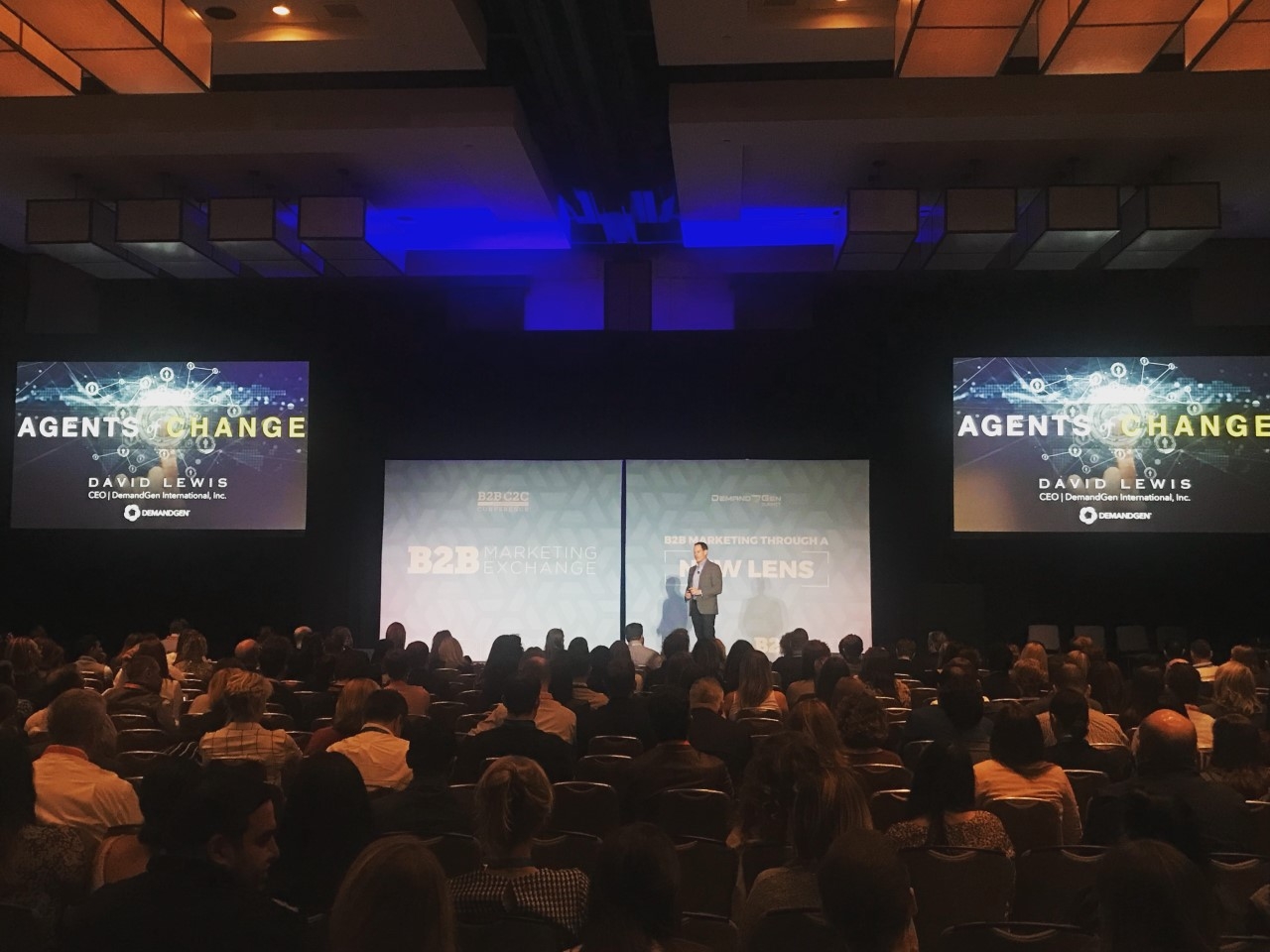There is one constant variable in the B2B ecosystem: change is inevitable and crucial to the continued growth of a business. This was a major talking point during the opening keynote at the B2B Marketing Exchange, in which DemandGen International CEO David Lewis took the stage to share tips and strategies to promote change within an organization to fuel growth and customer success.
Lewis began the session by highlighting how much the world has changed over the past several years. Cell phones, for example, were brand new in 2006 but are now commonplace and essential to people’s day-to-day lives. Lewis said that the same can be said about the buying experience — especially in the B2B world.
“When you think about the buying experience and how its changed, there is an app for everything,” Lewis said. “That innovation isn’t going to stop.”
Today’s change is being fueled by the needs and expectations of the customer. Lewis noted a statistic from Forbes that showed less than 25% of B2B companies focus on the customer experience. Lewis noted that positioning yourself as an agent of change within a business to focus more on customer experience is the ultimate deciding factor in future success.
“Customer experience has to be phenomenal,” Lewis said. “If you don’t have a company that cares about its clients, they won’t generate results. Customers now want convenience, value, quality, immediacy, choices, personalization, accessibility and affordability.”
“Change is the only constant in #B2B” @demandgendave kicking off #B2BMX right! pic.twitter.com/skEYHK8L5J
— Brian Anderson (@BranderSays) February 26, 2019
These changes in customer expectations have had a considerable impact on how businesses position themselves to meet their needs, according to Lewis. He went on to list the three types of businesses in the marketplace today:
- Born From Change: Lewis noted the company Stripe, which was formed by two San Franciscans who saw an opportunity to streamline and remove friction in the e-Commerce payments industry.
- Adapting To Change: Paychex, a payroll, HR and benefits outsourcing provider, was noted by Lewis because the company built its success on traditional field sales. Understanding they wouldn’t be able to keep going like that for the long term, they are now formulating a new game plan that is turning marketing into a Demand Factory.
- Born From Other’s Failures: A common example that Lewis highlighted here was Blockbuster. The company wasn’t willing to change, so much so that one customer ended up creating Netflix after having a terrible customer experience at the video rental chain. The company’s ultimate failure ended up creating one of the most successful digital streaming services available.
The Formula For Customer Success
“Customer experience > Expectations + Value” the formula for customer success from @demandgendave at #b2bmx pic.twitter.com/kWe0CMYnYL
— Brian Anderson (@BranderSays) February 26, 2019
During his session, Lewis shared a formula that helps quantify customer success:
Customer Experience > Expectations + Value
“You need to beat customer expectations or you will not have customers anymore,” Lewis said. “If you don’t expose all the goodness you can give them, you may be depreciating your company’s own customer experience.”
While B2B business is known for its long and complex sales cycles, Lewis noted that it doesn’t necessarily have to stay that way. He suggested that one of the best places to start when assessing the customer experience is to identify areas of “friction” that unnecessarily complicate aspects of the buying journey.
“We need to become frictionless,” Lewis said. “It’s time to take the friction out of everything. That’s what it takes to win. The companies born in this era start with no friction, and the companies that adapt take the friction out of their customer’s experience.”
Assessing The Demand Factory
.@demandgendave unveiling the “demand factory” at #B2BMX pic.twitter.com/YwTWEm1zCM
— Brian Anderson (@BranderSays) February 26, 2019
Lewis unveiled his company’s “Demand Factory” framework, designed to provide a holistic view of a streamlined B2B organization’s workflow — while also highlighting the tools and practices that impact each area.
Lewis broke the framework into four groups:
- Acquire: The area most B2B marketers today are familiar with, where a healthy mix of content, search, ad targeting strategies and more are leveraged to provide prospects the information they need to make a purchase decision.
- Convert: Dedication to conversion is essential for driving revenue. This is where lead prioritization comes into play — as well as new tools and trends such as AI and machine learning — to streamline sales rep efficiency and provide customers a personalized experience. Lewis added that this section is where marketing and sales ops roles are growing evermore important. “If you don’t have marketing and sales ops, you can’t run this efficiently,” he said.
- Measure: This is where attribution models are put in place to better understand marketing and sales effectiveness, while also providing opportunities to identify potential weak points in go-to-market strategies. “Ultimately, you can’t justify getting more [budget] for marketing without effective measurement,” Lewis added.
- Expand: 65% of revenue comes from customers. Your current customer base is where Lewis suggests B2B organizations set up their ABM pilots. “You have everything you need from an ABM standpoint here when it comes to data,” Lewis said. “If you don’t have data to target your own customers, you have no chance of seeing positive results with ABM on prospects.”
Lewis concluded by stating that companies should take these four focus points and grade themselves on overall effectiveness. This positions marketing and sales leaders to prioritize what they need to “align investments and resources to weak points and gaps in your framework,” Lewis noted.







